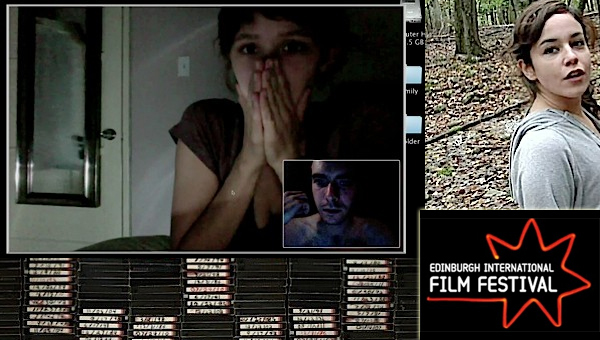httpvh://youtu.be/-uOISibzrUI
V/H/S opens with footage of some vile 20-something men, driving around looking for women, who they grab and force to expose their breasts to a video camera. We then see the men watching this footage back, congratulating themselves and talking about how they will sell the footage, and are going to move onto ‘up-skirt’ shots so they can receive bigger rewards.
The moustachioed alpha-jerk of the gang then tells them of an arrangement he’s made that’ll net them even more money: breaking into a house and stealing a certain videotape for someone. At the house, they find a corpse in an armchair, stacked televisions, and lots of tapes, which form the framing device for this engaging ‘found footage’ horror anthology.
Each of the 5 chapters is varied in tone and setting: the ‘found footage’ approach is used differently by each filmmaker, and some handle it more effectively than others. It’s the ones where cinéma vérité intersects with horror that shine out. There are some excellent editing and visual effects which make full use of the grainy videotape format to heighten the atmosphere, and provide scares. One short in particular, THE STRANGE THING THAT HAPPENED TO EMILY WHEN SHE WAS YOUNGER by Joe Swanberg and Simon Barrett, drives the viewer to scan the entire screen with trepidation, wondering what surprises lurk in the grainy backdrop.
The cumulative effect of the sexism (both casual and overt) across the short films in V/H/S suggests a critique of misogyny …
The special effects in this low-key production are consistently and unexpectedly impressive. Not so much frightening as cool and interesting, the shorts provoke plenty of grimacing, laughter and jump-scares. Pleasingly, the film also seems to comment on the portrayal of women in horror. The cumulative effect of the sexism (both casual and overt) across the short films in V/H/S suggests a critique of misogyny in general, and people’s everyday abuses and ideas of what constitutes consent, especially Adam Winberg’s framing sequence, and David Bruckner’s AMATEUR NIGHT. However, there is a scene in the end credits where the aforementioned shot of a woman being forced to show her breasts is repurposed and decontextualised for the benefit of the male gaze, which undermines a lot of the film’s anti-misogynist critique, making the good points made seem perhaps accidental, just the result of separate film-makers coincidentally all portraying violence towards women. It’s these parts that are most unsettling.
The misogyny is all too believable, and luckily the film for the most part avoids the type of titillation found in, for instance, CABIN IN THE WOODS. The supernatural events in each film, signalling a comeuppance for these awful people, are a guilty pleasure. On the whole, the quality is high, and V/H/S is one of those rare things – an anthology where each section is worth watching, and benefits the whole.



One thought on “V/H/S”
Comments are closed.